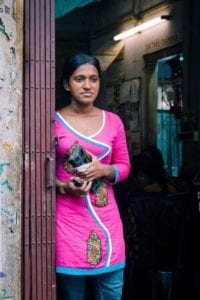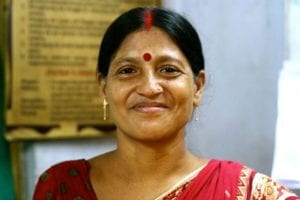Christine Janumala
Durbar Mahila Samanwaya Committee
Kolkata, West Bengal, India
Even amidst many colorful personalities in Sonagachi, Mita stands out. The first time I saw her, she was wearing a gorgeous green silk sari with stacks of bangles encircling her slim wrists. She struck me with her confidence and fashionability. We spoke briefly about her life after being rescued by the SRBs.
Today, for my independent interview with her, she is wearing a bright pink kameez tunic and jeans. She lacks the traditional Indian trifecta of adornment: two golden earrings and jeweled nose stud. Instead, she has a sandstone ring and a pearl ring. The nails on her left hand are long, very long, and patterned pink. The nails on her right hand, in common Bengali fashion, are trimmed short for mealtime efficiency. Even though she is by all appearances dressed-down, her petite figure’s gestures and grace still distinguish her. Her story reaffirms this dignity, providing a context from which her singular charm seems almost inevitable.

Mita, 24, is a singer. Even her laugh is musical as she recounts her desperate desire for fame when she was young. She spent all her time after school at music classes, invoking first the amusement and then the irritation of her family as her dream persisted into adolescence. One day, a family friend told her she could come to Kolkata to continue learning music and so she went. She would work as a maid to pay for her classes. She would live by the talent she loved.
At 16, after years of working as a maid or nanny and singing in her free time, she arrived in Sonagachi to look for work. Unaware that this was a red-light area, she was invited to join “the line” (to enter sex work). Upon arrival, she was brought before Durbar’s Self-Regulatory Board (SRB) members, who described the region and explained what working “the line” entailed.
Mita and the board members openly discussed the risks and dangers of the area, as well as the extensive support that the Durbar Mahila Samanwaya Committee offers. Finally, after three days in a safety home, Mita was asked whether she wanted to return to her family or work in an alternative position (because she was a minor, she would not be allowed to join sex work). After working as a receptionist, then a member of the cultural wing, she now serves as a board member on the very SRBs that rescued her many years ago.
Mita’s refinement comes from many years of singing lessons but her strength is hidden somewhere deeper. My interviews have concerned the counseling services available to women here, and when I ask Mita who she talks to in times of trouble, she answers with a laugh. “No one,” my translator relays with his own smile. “She says she doesn’t need to talk to anyone.” After a little probing, Mita explains that when she was little, before she ran away to follow her singing dreams, she used to talk with her stepmother. “After so many negative reactions,” she says, “I stopped talking. I sang instead.”
Paradigm Shifts and a Lesson in Expectations
My initial expectation as I planned my research was that the support services here would be desperately lacking. The SRBs offer extensive vocational counseling, in the perhaps odd form of helping a woman decide whether or not prostitution is the best fit for her. Considering the abuse that colors many sex-workers’ pasts and the under-addressed issue of child sexual abuse here (see Bitter Chocolate for an exploration of child sexual abuse in India), I assumed trauma counseling would be a great need in this community.

However, if there is a lack of such support, the women themselves don’t feel that way, as Mita and others have expressed. Rather, their community of peer educators, of fellow sex workers, of retired workers, of matronly malkins (madams), of sympathetic babus (regular clients) have been consistently rated as “safe,” “comfortable,” and “understanding.” Of course, this refers only to their perceptions of the community members they choose to speak to, rather than the community at-large. Still, even strong Mita claims that her stoicism regarding her past isn’t due to a lack of ready listeners.
Rather, she takes pride in her strength and determination. Once again, I find myself awe-inspired but this time it is accompanied by a good dose of empathy and surprise. Sonagachi has continued to contradict my expectation of sadness and despair. More importantly, the people I’ve met here have done me the service of complicating my perceptions of mental health, the application of rights, and beauty. Mita exemplifies how a striking personality or a particularly arresting face offer stories and surprise to the sympathetic listener. India has been a constant river of experience and often it’s hard to stop the current to really explore the depths. The challenge is always rewarding, and in the best of circumstances, enlightening.







